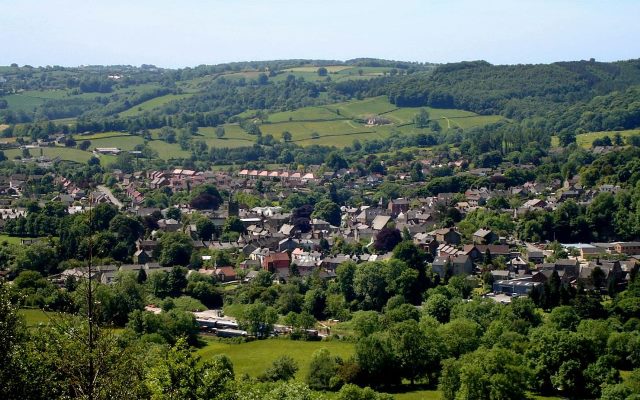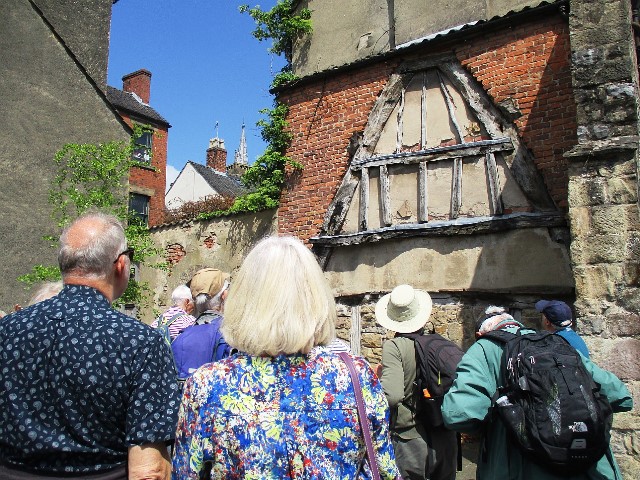 Wirksworth
Wirksworth
On a beautiful sunny May morning, twenty people boarded the coach for a day trip to the historic town of Wirksworth in Derbyshire. After the 9.15 start the coach proceeded through the Derbyshire countryside and the towns of Buxton, Bakewell, Matlock and Cromford, arriving at the Wirksworth Heritage Centre around 10.30. On the way Judith pointed out places of interest and the features of the landscape and its underlying geology, which gives the scenery its particular character.
We were welcomed at the Heritage Centre, provided with refreshments and given a talk by our guide for the day on the history of the town. The Heritage Centre is a modern conversion of an eighteenth century shop situated on the main road in the centre of town; it opened quite recently in 2019, and comprises a local museum on the two upper storeys, a gift shop and an excellent café.

Lead ore had been mined in the Peak District since Roman times and was originally extracted from fissures in the limestone (“rakes”), but when these were exhausted, pits were dug to extract the lead ore. The lead sulphide (galena) was smelted with charcoal and the extracted lead metal was a valuable resource, which made several local families very rich. The heyday of the lead industry was from the 16th century up to about 1900, by which time all the mines had been exhausted at accessible depths. In principle, anyone could open a mine provided he paid the appropriate taxes and this process was regulated by the “Barmote Court” held in the town (this still meets in an honorary form today); however, over time, certain local families including the Gells, Hurts and Hopkinsons, managed to establish control over the industry and reap the financial benefit.
Modern textile manufacturing began with Richard Arkwright’s pioneering mill at nearby Cromford and silk and cotton mills were set up in Wirksworth around the beginning of the 19th century; some of these specialised in production of ribbon fabrics including “red tape” for tying up bundles of legal documents. However, with the decline of the lead industry, limestone quarrying became the dominant local industry in the twentieth century. This led to a decline in the fortunes of the town until the 21st century, when after a major injection of capital for rejuvenation, it has become a centre for artists and media projects.
After the talk, we visited the museum to see the exhibits relating to the town’s history, eat lunch and take a look round the town. I also managed to take a quick visit to the nearby heritage Ecclesbourne Valley Railway, which was operating classic diesel hauled trips on the day.

Ecclesbourne Valley Railway
At 2.15 we all gathered outside the Centre for a guided tour around the historic features of the town. A first impression is how little the architecture of the buildings have changed since the prosperous times of the 19th century; the relative decline in the town’s importance during most of the 20th century has meant that few of the buildings have been replaced by modern equivalents and this has brought benefits today in its appeal to both residents and tourism. Indications are also present showing the outline of now demolished medieval buildings, which remain on standing buildings.

The guide pointed out Walham House (residence of another mine owning family) and the original bank set up by Richard Arkwright and John Toplis in 1780, which eventually became part of Lloyds Bank. The side roads in the town run steeply up the hill with many interconnecting alleyways, which we were encouraged to explore. Underneath the roads and the Market Place there still remain the tunnels and drainage channels, a legacy of previous mining activity. At the end of one road was a building, which was once a late 18th century silk mill; this building has also been the previous site of the Heritage Centre, but it has since been converted into housing.
We then crossed the road to view St. Mary’s church and vicarage. The church has been traced back to Anglo-Saxon times, but the present building mostly dates back to 13-15th century with some Victorian restoration; the building is much larger than one might expect for a town of this size and reflects the prosperity of the town during these two periods. While we were there, a symphony orchestra was rehearsing and it only occupied a quarter of the floor area.

In rehearsal
As well as hosting impressive stained-glass windows and medieval tombs, the church has incorporated into its internal walls, two 7th century stone carvings, which were found in the church grounds during renovations including the “T’owd Man”, a very early depiction of a miner going to work.
Altogether, it was a very enjoyable visit to a most interesting town. On the journey home we took a slightly different route and the Derbyshire countryside was resplendent in the evening sunshine; we arrived back home around 6pm.

